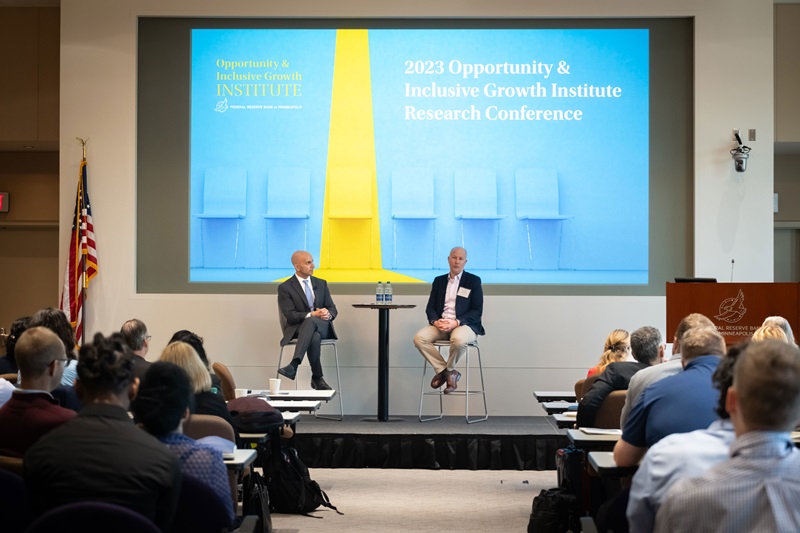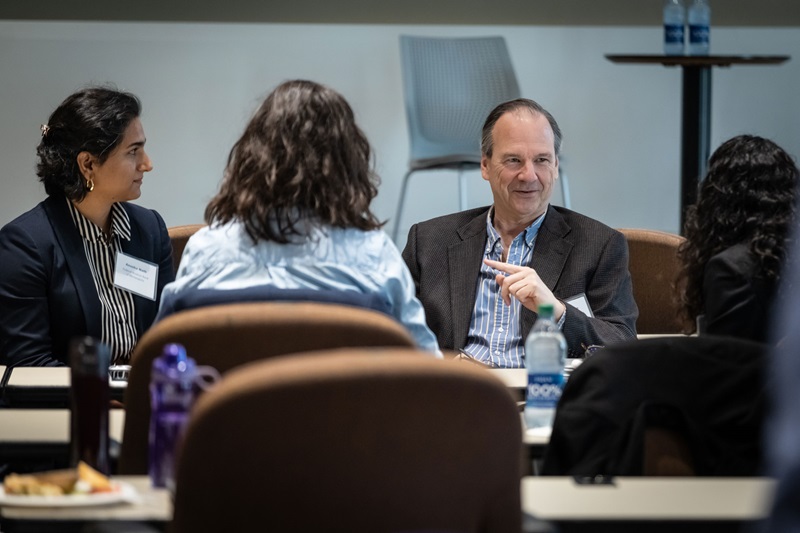2023 Institute Research Conference
October 5, 2023 | 9:00 a.m. – 5:00 p.m. CT
Federal Reserve Bank of Minneapolis
Minneapolis, Minnesota

- Full event(video)
The Opportunity & Inclusive Growth Institute will host its 2023 research conference on October 5, 2023. This event will showcase the range of frontier-style research with which the Institute engages. Papers will discuss questions related to the Institute’s mission of supporting the Federal Reserve’s mandates through research into how to enhance economic opportunity and achieve inclusive growth.
The event’s keynote speaker will be Jed Kolko, Under Secretary of Commerce for Economic Affairs. Secretary Kolko coordinates economic analysis for the U.S. Department of Commerce and provides direction and oversight for the Census Bureau and the Bureau of Economic Analysis. Before joining the Commerce Department, Kolko served as chief economist at Indeed, a global jobs site, and Trulia, an online real estate firm.
The program and photos from last year’s conference can be found here. Last year’s event welcomed an in-person audience of more than 100 people and the event recording has reached more than 2,200 views.
The conference will be preceded by a dinner for presenters and discussants as well as the Institute’s advisory board members, economists, and leadership to engage in broad and deep conversation about research around opportunity and inclusive growth. The program committee for the conference is Robynn Cox, Niklas Engbom, Alessandra Fogli, Andrew Goodman-Bacon, John Bailey Jones, Amanda Michaud, Raven Molloy, and Simon Mongey.


Event Agenda
Thursday, October 5 |
|
|---|---|
| 9:00 a.m. – 9:30 a.m. CT |
Welcome |
| 9:30 a.m. – 9:40 a.m. CT |
Opening remarksAbigail Wozniak, Federal Reserve Bank of Minneapolis |
| 9:40 a.m. – 10:20 a.m. CT |
Keynote and Q&A
|
| 10:20 a.m. – 11:10 a.m. CT |
The Limited Impact of Free College Policies [Paper]María Marta Ferreyra, World Bank; Carlos Garriga, Federal Reserve Bank of St. Louis; Juan David Martin-Ocampo, Banco de la República Colombia; Angelica Maria Sanchez-Diaz, Georgetown University Presenter: Carlos Garriga, Federal Reserve Bank of St. Louis [Slides] |
| 11:10 a.m. – 12:00 p.m. CT |
Childhood Exposure to Violence and Nurturing Relationships: The Long-Run Effects on Black Men [Paper]Dionissi Aliprantis, Federal Reserve Bank of Cleveland; Kristen Tauber, New York University Presenter: Dionissi Aliprantis, Federal Reserve Bank of Cleveland [Slides] |
| 12:00 p.m. – 1:00 p.m. CT |
Lunch |
| 1:00 p.m. – 1:50 p.m. CT |
Riding the Waves: Inequality and Adaptation to Extreme Temperatures in a Changing Climate [Paper]Stephie Fried, Federal Reserve Bank of San Francisco Presenter: Stephie Fried, Federal Reserve Bank of San Francisco [Slides] |
| 1:50 p.m. – 2:40 p.m. CT |
A Theory of Non-Coasean Labor Markets [Paper]Julio Andrés Blanco, University of Michigan at Ann Arbor; Andrés Drenik, University of Texas at Austin; Christian Moser, Columbia Business School; Emilio Zaratiegui, Columbia University Presenter: Christian Moser, Columbia Business School [Slides] |
| 2:40 p.m. – 3:00 p.m. CT |
Break |
| 3:00 p.m. – 3:50 p.m. CT |
The Downward Spiral [Paper]Jeremy Greenwood, University of Pennsylvania; Nezih Guner, Universitat Autonoma de Barcelona; Karen A. Kopecky, Federal Reserve Bank of Cleveland Presenter: Karen A. Kopecky, Federal Reserve Bank of Cleveland [Slides] |
| 3:50 p.m. – 4:40 p.m. CT |
Market Response to Racial Uprisings [Paper]Bocar Ba, Duke University; Roman G. Rivera, University of California, Berkeley; Alexander Whitefield, Wharton School of the University of Pennsylvania Presenter: Bocar Ba, Duke University [Slides] |
| 4:40 p.m. – 4:50 p.m. CT |
Closing remarks |
| 4:50 p.m. – 6:30 p.m. CT |
Networking and social hour |
Session moderators are Amanda Michaud, Illenin Kondo, and Andrew Goodman-Bacon, Federal Reserve Bank of Minneapolis.

Paper Summaries
Childhood Exposure to Violence and Nurturing Relationships: The Long-Run Effects on Black Men
Dionissi Aliprantis, Federal Reserve Bank of Cleveland; Kristen Tauber, New York University
Over a quarter of Black men in the United States witness a shooting as a child. Aliprantis and Tauber identify the causal impact of this exposure on long-term earnings of Black men by comparing Black children who witnessed a shooting with children with similar characteristics who did not. They find Black adults who were exposed to gun violence before the age of 12 had earnings 26 percent lower than their counterparts who had not witnessed violence. However, having nurturing relationships as a child is nearly as beneficial as preventing the exposure to violence. Utilizing their findings, the authors find that scalable childhood nurturing programs such as Boys & Girls Clubs have a positive impact that exceeds their costs. The paper highlights how childhood nurturing programs reduce the effects of childhood exposure to gun violence.
Market Response to Racial Uprisings
Bocar Ba, Duke University; Roman G. Rivera, University of California, Berkeley; Alexander Whitefield, Wharton School of the University of Pennsylvania
Do investors anticipate the impact of racial uprisings on firms? Ba and co-authors find evidence that the Black Lives Matter (BLM) movement affected publicly traded companies that provide equipment or training to police forces. The authors find that valuations of firms strongly connected with police forces increased by 7 percentage points relative to similar firms without police connections over a 21-day period after BLM protest movements. This net gain is the result of investors anticipating that police forces would require greater funding for reform efforts. The paper provides an interesting case study on how societal forces can shape financial sector outcomes.
Riding the Waves: Inequality and Adaptation to Extreme Temperatures in a Changing Climate
Stephie Fried, Federal Reserve Bank of San Francisco
Millions of Americans grappled with record-breaking triple-digit temperatures this past summer. How will the cost of climate change be distributed across society? Deriving results from a model, Fried finds that the adverse welfare effects of temperature rises will fall disproportionally on lower-income individuals. This effect is more pronounced in hotter regions, where poorer households will spend a greater share of their income to cool their home. The model captures how low-income households with little savings struggle to cope with temperature changes. Fried incorporates energy transfers such as the Low-Income Home Energy Assistance Program (LIHEAP) in her analysis, which could potentially ease the burden on households with little savings.
The Limited Impact of Free College Policies
María Marta Ferreyra, World Bank; Carlos Garriga, Federal Reserve Bank of St. Louis; Juan David Martin-Ocampo, Banco de la República Colombia; Angelica Maria Sanchez-Diaz, Georgetown University
Education has been shown to increase social and economic mobility for some graduates. However, the costs of higher education can server as a barrier to matriculation. Subsidized or fully funded college programs have been proposed in order to reduce this barrier. Ferreyra and co-authors assess the impact of these programs on both enrollment as well as on graduation rates. Fully funded and need-based programs did increase enrollments, but they did not lead to an increase in graduation rates. Only performance-based aid programs led to an increase in graduation rates. This paper provides a tool that incorporates both graduation and enrollment rates in its cost-benefit analysis of higher education aid programs.
The Downward Spiral
Jeremy Greenwood, University of Pennsylvania; Nezih Guner, Universitat Autonoma de Barcelona; Karen A. Kopecky, Federal Reserve Bank of Atlanta
Since 2000, nearly 500,000 Americans have lost their lives due to opioid overdoses, and the number of deaths has spiked in the last five years with the introduction of synthetic opioids, such as fentanyl. The goal of Greenwood and co-authors is to understand the causes of this trend. The authors create a model that shows the increase in opioid use and subsequent overdose deaths were the result of a combination of decreasing prices, increasingly lethal opioids in the form of fentanyl, and misinformation about the dangers of addiction. The authors also find that the increase in the prescribed strength and length of time for opioid use were not significant drivers of overdoses. The paper has several findings relevant to policy making around opioid use. First, the paper highlights that widening access to overdose prevention drugs, such as Naloxone, can reduce fatalities. However, the authors caution that any policy that reduces overdoses also reduces the cost of opioid use, leading to an increase in the use of opioids.
A Theory of Non-Coasean Labor Markets
Julio Andrés Blanco, University of Michigan at Ann Arbor; Andrés Drenik, University of Texas at Austin; Christian Moser, Columbia Business School; Emilio Zaratiegui, Columbia University
Blanco and co-authors develop a theory of labor markets that incorporates realistic features, such as job market search frictions and wages, that do not quickly adjust to price changes. The theory provides novel dynamics surrounding inefficient job separations that happen when the worker and firm would have been better off had the separation not occurred. Using variables such as wage fluctuations that can be captured in real-world data, the authors derive the prevalence of inefficient job separations. This is then used to characterize how the labor market responds to price changes—in particular, how employment and wages respond. The theoretical results show inflation can decrease wages relative to a worker’s productivity. However, this depends on how quickly wages adjust to the new price level.

EARLY CAREER RESEARCHERS’ WORKSHOP
The early career researchers’ workshop will be held Friday, October 6, in person at the Federal Reserve Bank of Minneapolis. This event is an opportunity to provide constructive feedback and networking opportunities to scholars up to 10 years post-Ph.D. Attendance will be by invitation only, and the event will not be recorded or posted later. We encourage you to visit participants’ webpages to engage with their scholarship.
Workshop Agenda
Friday, October 6 |
|
|---|---|
| 8:30 a.m. – 9:00 a.m. CT |
Welcome and breakfastPresenter: Alessandra Fogli, Federal Reserve Bank of Minneapolis |
| 9:00 a.m. – 9:45 a.m. CT |
The Effects of Gentrification on Household Finance and MobilityAditya Aladangady, Federal Reserve Board of Governors; Jacob Krimmel, Federal Reserve Board of Governors Presenter: Jacob Krimmel, Federal Reserve Board of Governors |
| 9:45 a.m. – 10:30 a.m. CT |
Endogenous Bargaining Power and Declining Labor Compensation ShareJuan C. Córdoba, Iowa State University; Anni T. Isojärvi, Federal Reserve Board of Governors; Haoran Li, Renmin University of China Presenter: Anni Isojärvi, Federal Reserve Board of Governors |
| 10:30 a.m. – 10:45 a.m. CT |
Break |
| 10:45 a.m. – 11:30 a.m. CT |
Public Education and Intergenerational Housing Wealth EffectsMichael Gilraine, New York University; James Graham, University of Sydney; Angela Zheng, McMaster University Presenter: Angela Zheng, McMaster University |
| 11:30 a.m. – 12:15 p.m. CT |
Lunch |
| 12:15 p.m. – 1:00 p.m. CT |
Central Bank Digital Currency: Financial Inclusion vs. DisintermediationJeremie Banet, University of California, Irvine; Lucie Lebeau, Federal Reserve Bank of Dallas Presenter: Lucie Lebeau, Federal Reserve Bank of Dallas |
| 1:00 p.m. – 1:45 p.m. CT |
Some Like It Hot: Inclusive Monetary Policy Under Okun's HypothesisFelipe Alves, Bank of Canada; Giovanni L. Violante, Princeton University Presenter: Felipe Alves, Bank of Canada |
| 1:45 p.m. – 2:00 p.m. CT |
Break |
| 2:00 p.m. – 2:45 p.m. CT |
The Parenthood Gap: Firms and Earnings Inequality After KidsRebecca Jack, University of Nebraska–Lincoln, Lincoln; Daniel Tannenbaum, University of Nebraska–Lincoln; Brenden Timpe, University of Nebraska–Lincoln Presenter: Brenden Timpe, University of Nebraska–Lincoln |
| 2:45 p.m. – 3:30 p.m. CT |
Small group discussions |
Session moderators are Mallika Thomas, Abigail Wozniak, Amanda Michaud, and Alex Albright, Federal Reserve Bank of Minneapolis.

Event Details
Minneapolis, Minnesota
